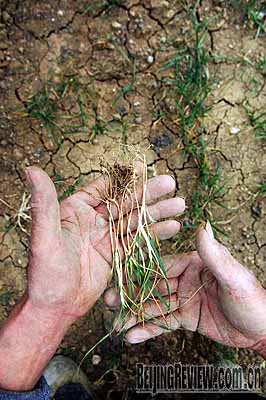|
Since last November, a severe drought has hit China's major wheat production areas.
 |
|
POOR CROPS: A farmer in Baishan Town, Suzhou City, Anhui Province, checks wheat crops in the dry land on February 12 (LI JIAN) | As of February 17, drought-beaten wheat lands in Henan, Hebei, Shanxi, Jiangsu, Shaanxi, Gansu, Anhui and Shandong provinces included 5.04 million hectares, with 1.97 million hectares severely affected. These totals had decreased by 1.45 million hectares and 344,520 hectares, respectively, compared to the previous day thanks to efforts by all levels of government, according to the Ministry of Agriculture.
North China is the country's major grain-producing region, covering 65 percent of total national grain production. Worldwide concern grows over whether such a drought will affect China's wheat supply and trigger grain shortages and rising grain prices.
Going all out
"We have been effective in fighting against a drought disaster," said Vice Governor Liu Mancang, who heads agriculture in Henan Province.
Henan, in central China, is the country's breadbasket. It produces over one quarter of summer grains and 10 percent of all grains throughout the year. In 2009, Henan will harvest 5.29 million hectares of summer grain, of which 5.26 million hectares are wheat crops.
As of February 13, there still had been about 600,000 hectares of wheat fields being severely impacted out of a total 3.67 million hectares affected by the drought.
"This severe drought has revealed problems in our irrigation systems," said Liu.
Because of continuous harvests over the past five years, some local governments neglected construction and maintenance of their irrigation systems.
Meanwhile, some local governments that have been focusing on constructing irrigation facilities have faced few difficulties during this drought. Jiaxian County, in Henan's center, has been building such structures. In 2001, the county government constructed a 35-km channel, expanding irrigated areas by 10,000 hectares. Despite the severe drought, the channel can provide enough irrigation for wheat near it.
"The more we invest in building irrigation systems, the more benefits people will get," said a local government official.
Impact on grain production
In 2008, China's grain production reached 530 million tons, with five years of good harvests in a row that produced at least 380 kg of grain per person.
However, the Central Government was not so optimistic. In November 2008, the National Development and Reform Commission released the Issues on National Framework for Medium-to-Long-Term Food Security 2008-2020, saying that China still faces many challenges in terms of grain safety, including "difficulties in increasing grain production" and "a tight balance between supply and demand of grain."
|
